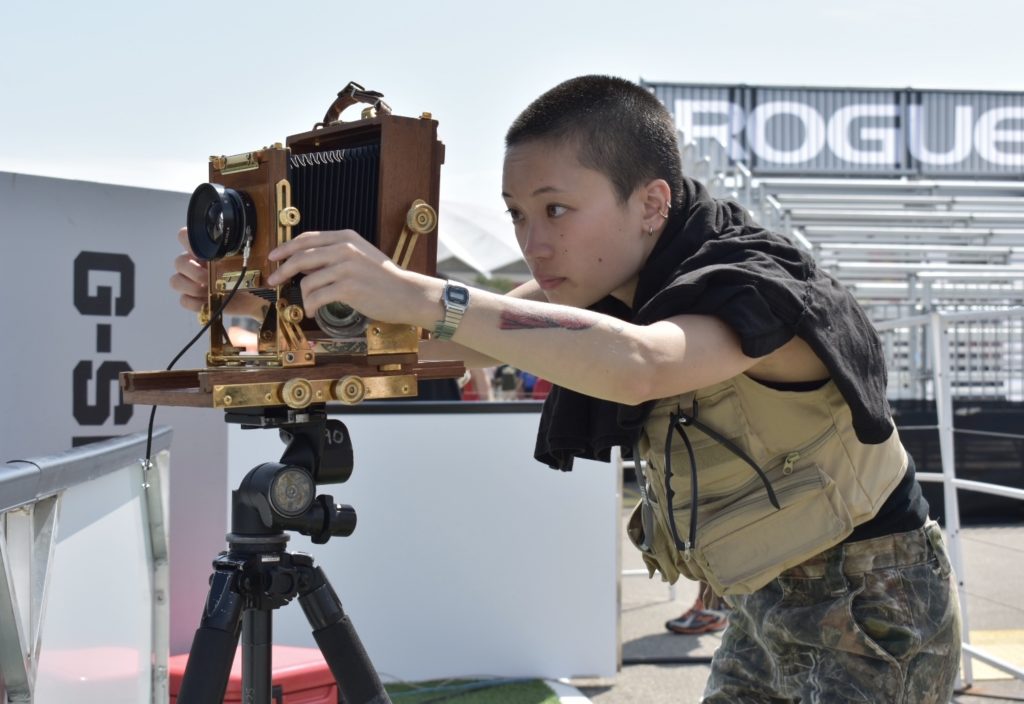“Athletes,” the announcer’s voice echoed over North Park at the 2023 NOBULL CrossFit Games.
“One minute.”
The line of masters men and women, 55-59, braced themselves for Pulling Power, preparing to run to their ropes at the sound of the buzzer.
Across the field, in the press pit’s southeast corner, Maddie Conlin-Day readied herself, too. She crouched before what looked like an accordion on a tripod: an 18th-century Zone VI large-format folding field camera (its handsome gold-and-mahogany body makes up for its mouthful of a name).
“It’s my preferred method of shooting,” Conlin-Day — a photographer and fine artist based in Chadds Ford, Pennsylvania — explained. She tossed a black cloth over her head and peered through the ground glass, a translucent glass panel frosted on one side and etched with grid marks to help the photographer compose shots.
As its name implies, large-format photography uses larger film — in this case, 4-by-5-inch sheets — than the more-common 35-millimeter variety. This allows for better quality and detail in larger prints.
Much of Conlin-Day’s work is experimental and abstract. But today, she’s turning her lens to elite fitness — in particular, that of the masters athletes.
“It’s really impressive, what they do,” she said.
She would know. Her mother, Karen Conlin, took 65th in the 2023 Age-Group Quarterfinal in the Women’s 65+ division.
“My mom really wants to make it to the Games,” said Conlin-Day — who recently started CrossFit herself at CrossFit Kennett Square, the same affiliate her mother attends.

Shooting large format, Conlin-Day continued, is an artistic nod to the perseverance it takes to accomplish such a feat.
“It’s kind of a great sort of metaphor for what the athletes are doing,” she said. “You see them put in all the hard work and take the time to get to this point.”
Large-format photography requires practiced hard work, too.
First, the camera must be leveled on its tripod (tiny levels are, helpfully, built into the camera body).
Then, beneath the black cloth, Conlin-Day looks through the ground glass (there is no viewfinder) at the image — upside down and reversed — with the aid of a loupe, a magnifier shaped like a shot glass. Brass knobs on the side of the camera body control focus, and the shutter is released by pulling a cable. To switch between portrait and landscape orientations, the entire ground glass must be removed and rotated.
It’s a lot of work for one shot — which is all there’s room for on each sheet of film.
“It takes patience because you have to pick and choose what you’re shooting; there’s no backup,” Conlin-Day continued.
She gestured to the athletes on the field.
“Like at this point, there’s no backup (for) them. They (have to) put it all on the table.”
As the athletes moved closer upfield, Conlin-Day began to set up her shot. After, she’d move the camera to the start line to get a better view of the silver-haired men and women scaling the 16-foot ropes hanging from the Zeus rig.
Hopefully, she said, her work will help inspire others, young and old.
“And show them that they can be the best they can be — and make it to the Games, even.”
About the Author
Brittney Saline is Senior Writer and Editor for CrossFit, LLC. Previously, she was a writer and editor for the CrossFit Journal. She’s been sharing powerful stories from and for the CrossFit community since 2012, covering topics ranging from problems with healthcare and Big Pharma to CrossFit’s potential for reversing symptoms of Parkinson’s disease to discourses on femininity and musculature. She lives in Minneapolis, Minnesota, and her favorite CrossFit workouts feature lots of heavy lifting. Got a story to share? Email Brittney here.

A Metaphor on Film